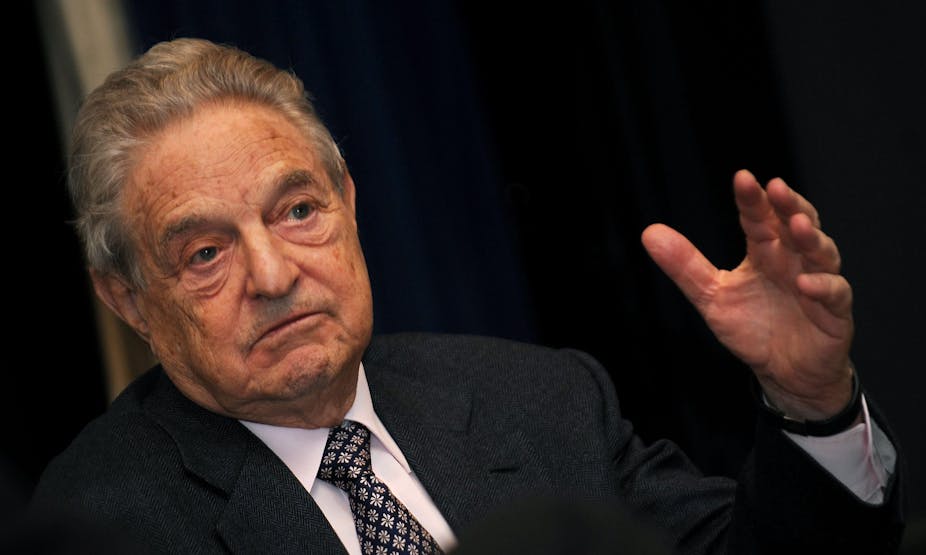This week, octogenarian billionaire and well-known philanthropist George Soros will convene a global meeting of the advisory boards of his Open Society Foundation to discuss global poverty, health, climate change and conflict.
More than 200 board members from the various initiatives will converge on Budapest to reflect on past achievements, compare notes and debate matters such as whether “Global Health has had its decade” and the social dimensions of climate change around rights, governance and equity.
Soros is famous as the man who broke the Bank of England in 1992 and is noted as one of world’s most successful hedge fund entrepreneurs. He is both regaled and reviled for his philanthropy and support of liberal causes. He caused a big splash in 2010 with his $100 million gift to Human Rights Watch.
Soros set up the Open Society Foundation (OSF) to promote the values and principles of a free and open society around the world and has given $8 billion over three decades to a vast array of causes.
Despite the increased popularity of what is now termed “philanthrocapitalism,” data on private foundations giving to international development causes is surprisingly poor. The World Bank made attempts to quantify the scale of giving last decade and the results were sobering: in 2005, roughly $4.5 billion was devoted to international development. This must be compared to the $100 billion or so that the OECD Development Assistance Committee estimated to be the total of official development assistance around the same time.
Once the modest contributions of private philanthropy became evident, and that barely 1% of all the world’s foundations conduct activities that touch on developing countries, the World Bank shifted its analytic concerns to more pressing matters brought on by the global financial crisis. Many foundations also suffered a blow to their financial base and were less able to commit to new developments.
Soros began his philanthropic activity in 1979 when he provided scholarships for black students in apartheid South Africa to attend Cape Town University. The Open Society Foundations were established five years later. His foundation activities have been a capstone to a colourful career in high finance, an eventful childhood surviving the Nazi occupation of Hungary during World War II and post-war imposition of Stalinism before he fled to England where he completed his studies at LSE. Inevitably, with his foundation providing a podium in civil society to make pronouncements on various issues of day, public and media attention has focused on the man, not the organisation.
In contrast to other large private foundations, the Open Society Foundation is run as a horizontal international network of autonomous groups. OSF grew not as one institution with a single head office in New York, but with a flat structure where the national bodies and the initiatives are free standing and often operate independently with their own sub-boards. It is both an operational foundation, delivering its own programs, and a grant-making body.
The early days were characterised by a concentration of talented and motivated people with the ability to spark new programs and drive them with limited subsequent oversight. Most support in the early days centred around the dissident movements in Eastern Europe’s Communist countries to help promote tolerance, democratic governance, human rights, and the rule of law where one-party dictatorships exercised a monopoly on power. The fall of the Berlin Wall prompted a scaling up of support to grass-roots groups, civil society organisations and new political groupings in the transitioning economies and societies of the former Soviet Union.
The subsequent EU accession process for candidate countries also brought a new wave of funding support to universities, advocacy groups and government watchdog groups in the region. But the accession process for the ten new member states to the EU was also an important factor prompting a global shift in the foundation.
Globalisation has facilitated the spread of these ideas. Likewise, there was thinking in the Network that the experiences of transition might be translatable to Asia, Latin America and Africa. Since the turn of the century, there has been a mushrooming of international initiatives to support the democracy movement in Burma to programs promoting transparency in resource management in West Africa.
At the same time, the professional maturing of both the foundation and many of its officers brought a gradual policy turn from grass-roots activism more towards expert analysis. Not just seeking to improve the civil rights of individuals and the well-being of communities like the Roma, for the past decade there has also been a desire for policy impact.
For an organisation that was once “low on bureaucracy”, its growing size, geographical spread and mounting financial disbursements has required better reporting, accountability measures and institutionalisation of procedures. Giving $1 billion away each year – across countries with quite different legal regimes – is a very complicated process.
The network sprawls across more than 40 offices and independent foundations worldwide. One part of the network can be unaware of relevant activity elsewhere in OSF. The new President at the helm, Chris Stone, direct from the Hauser Center for Nonprofit Organizations at Harvard University, will have a mammoth task of exploring ways to unify the foundation’s far-flung staff and strategies. Before setting the world to rights, there is much to do to connect the network with itself.

